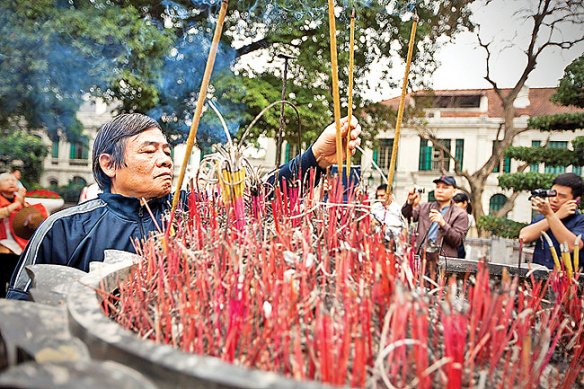Since the Sino-Vietnamese war of 1979 – a period of 36 years – there has not been one single war between states in the whole of East Asia, a region comprising one third of mankind, and which was ravaged by some of the word’s worst wars from the 1840s to the 1970s. There have been internal armed conflicts in several Southeast Asian countries since then (Cambodia, Indonesia, Laos, Myanmar, the Philippines, Thailand) but no interstate wars.

Vietnamese protesters burn incense to pray on the anniversary of 64 Vietnamese soldiers who died on 14 March 1988 during an attack by Chinese soldiers on Gac Ma island, one of the disputed Spratly Islands. EPA/Luong Thai Linh
Yet there have been some serious incidents, like the sinking of the South Korean warship Cheonan in 2010, presumably by a North Korean torpedo, and artillery shelling at a disputed part of the border between Cambodia and Thailand in 2008-11, near the ancient temple of Preah Vihear.
The incident that most resembles something that might re-occur in the near future is a battle between Chinese warships and poorly armed Vietnamese soldiers on 14 March 1988 at Johnson South Reef in the Spratly area in the southern part of the South China Sea. The scattered Spratly islets are claimed in full by China, Taiwan and Vietnam, most of them also by the Philippines, and some by Malaysia and Brunei. When Chinese naval forces arrived there in 1987-88, all the islets had already been occupied by other states. China’s People’s Liberation Army Navy (PLAN) did not try to conquer islets from those who held them but instead took possession of a number of underwater reefs or low-tide elevations, some of which may or may not have included tiny rocks sticking above water at high tide. When Chinese warships approached the South Johnson Reef, near the Vietnamese-held Sin Cowe island, the Vietnamese sent a small vessel with tiny boats to forestall the Chinese invasion and take possession of the reef on behalf of Vietnam. A number of troops waded onto the submerged reef, and planted a Vietnamese flag. The Chinese saw this as a provocative act since the reef in their view belonged to China. So the Chinese ships approached. An order was heard: “Fire!”. Shortly afterwards all the Vietnamese soldiers lay dead or wounded in the water. The Chinese ship then fired its canons at the Vietnamese boat, which sank together with its crew. More than sixty Vietnamese died that day.
In 2009, a film with Chinese footage of the event appeared on the web, which soon became a “lieu de mémore” for Chinese and above all Vietnamese netizens. You may see the footage with a patriotic Chinese text overlay here:
And a version with Vietnamese patriotic text overlay here:
The Vietnamese version adds film from later memorial events at Sin Cowe island to honour the martyrs, and tells how young Vietnamese soldiers today are ready to fight and die if China attacks again.
In the meantime China has built artificial islands on seven reefs in the Spratlys. At the website of the The Asia Maritime Transparency Initiative’s Island Tracker (use a browser) you may see what Johnson South Reef, and China’s six other Spratly reefs look like today. They are no longer submerged reefs but fully constructed artificial islands with helipads, harbours, lighthouses and dwellings. It is uncertain, however, how long they can withstand the heavy winds that storm through the South China Sea every year, since there is no natural barrier to protect the installations against the waves.
Remember from the footage what Spratly South Reef looked like in 1988. At that time it was visible only as a flat area of strangely quiet water surrounded by huge, breaking waves.
Among the most likely possible scenarios for an outbreak of war in East Asia today is another clash over small disputed islets in the South China Sea.
- This text was written in Yangon to accompany a lecture about the East Asian Peace, the Peace Research Course, International Summer School, University of Oslo, 24 July 2015.